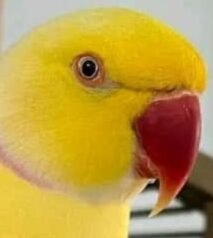Training a parrot isn’t just about showing off fun tricks—it’s about building trust, encouraging good behavior, and creating a strong, lifelong bond. Parrots are incredibly smart and social creatures. Without proper training and stimulation, they can develop unwanted behaviors like biting, screaming, or feather plucking.
Whether you’re teaching your bird to step up on your hand, speak clearly, or even use a designated potty spot, consistent training and positive reinforcement will take you far. Let’s break it all down.
🖐️ 1. Step-Up Command Training
The “step-up” command is the most basic and essential behavior every parrot should learn. It’s the foundation of good handling and communication.
How to Train:
- Gently place your finger or a perch near your parrot’s lower chest.
- Say, “Step up” in a clear, calm voice.
- When the parrot steps up, reward immediately with a treat or praise.
- Practice daily, in short, calm sessions.
🧠 Tip: Never yank or push the bird to force it to step up. This breaks trust. Be patient and persistent.
🗣️ 2. Teaching Your Parrot to Speak
Many parrots are natural mimics, especially species like African Greys, Amazon parrots, and Budgies. With repetition and encouragement, your parrot can learn to say words and even full phrases.
Steps:
- Pick a simple word like “hello” or your parrot’s name.
- Repeat the word with enthusiasm several times a day.
- Reward any vocal attempt with treats and affection.
- Use the word in context—say “hello” when entering a room, or “bye” when leaving.
🎤 Tip: Use excitement and tone. Parrots are more likely to mimic words that sound emotional or fun.
🚽 3. Potty Training Basics
While it sounds far-fetched, potty training is possible with parrots—especially if you observe their natural behavior.
How To Start:
- Watch for signs your parrot is about to go (like tail lifting or squatting).
- Gently move them to a designated area (e.g., perch over a newspaper or trash bin).
- Use a verbal cue like “go potty” consistently.
- Reward with praise or a small treat when successful.
💡 Reminder: Accidents will happen. Never punish your parrot—it causes fear, not learning.
🛑 4. Preventing & Correcting Biting Behavior
Biting is usually a result of fear, frustration, or lack of boundaries. Instead of punishing, focus on understanding the cause and redirecting behavior.
Prevention Tips:
- Respect your bird’s body language. If they fluff up or back away, give them space.
- Don’t force interaction when your parrot is tired or stressed.
- Always use positive experiences to build trust.
If a Bite Happens:
- Gently put the parrot down without yelling or showing fear.
- Stay calm and give it space.
- Revisit training and slowly rebuild trust.
🧠 Training Tip: Reinforce gentle beak behavior by rewarding touches that are soft and controlled.
🖱️ 5. The Importance of Clicker Training
Clicker training is a powerful tool that helps parrots associate a behavior with a reward. It speeds up learning and makes communication clear.
How it works:
- Get a small clicker or make a unique sound.
- Click immediately when your parrot does something right.
- Follow with a treat every time.
- Over time, the click becomes a bridge between good behavior and the reward.
⚡ Example: When teaching “step up,” click the moment their foot touches your finger, then treat.
🎯 Why it Works: It creates instant feedback. The bird knows exactly what behavior earned the treat.
💬 Final Thoughts
Training your parrot is one of the most rewarding aspects of ownership. It keeps your bird mentally stimulated, deepens your bond, and leads to a better, calmer household. Remember:
- Keep sessions short and consistent (5–10 minutes, 2–3 times a day)
- Always end on a positive note
- Use only positive reinforcement—never punishment
- Be patient; every bird learns at their own pace
With time, love, and a little seed-based bribery, your parrot will amaze you with what it can learn!





